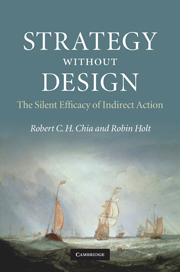Book contents
- Frontmatter
- Contents
- Preface
- Introduction
- 1 Spontaneous order: the roots of strategy emergence
- 2 Economic agency and steps to ecological awareness
- 3 Reconceptualizing agency, self-interest and purposive action
- 4 The ‘practice turn’ in strategy research
- 5 Building and dwelling: two ways of understanding strategy
- 6 Strategy as ‘wayfinding’
- 7 The silent efficacy of indirect action
- Epilogue: Negative capability
- Notes
- Index
5 - Building and dwelling: two ways of understanding strategy
Published online by Cambridge University Press: 22 January 2010
- Frontmatter
- Contents
- Preface
- Introduction
- 1 Spontaneous order: the roots of strategy emergence
- 2 Economic agency and steps to ecological awareness
- 3 Reconceptualizing agency, self-interest and purposive action
- 4 The ‘practice turn’ in strategy research
- 5 Building and dwelling: two ways of understanding strategy
- 6 Strategy as ‘wayfinding’
- 7 The silent efficacy of indirect action
- Epilogue: Negative capability
- Notes
- Index
Summary
The ordinary practitioners…live ‘down below’… [T]heir knowledge…is as blind as that of lovers in each other's arms.
Michel de Certeau, The Practice of Everyday Life, p.93In the previous chapter we showed how research on strategy, and in particular the recent strategy-as-practice movement, retains affiliations with a strong methodological individualism. We then moved on to show how the practice turn in social theory offers an alternative way of understanding strategy-in-practice in terms that are compatible with a weakened notion of human agency and with the kind of non-deliberate purposive action that we associate here with undesigned strategy. In this chapter, therefore, we draw from Martin Heidegger and the Heideggerian commentator Hubert Dreyfus, as well as sociologists and social anthropologists such as Pierre Bourdieu, Michel de Certeau and Tim Ingold, to identify two distinct modes of engaging with the world strategically that, following Heidegger, we term the ‘building’ and ‘dwelling’. Although Heidegger conceives of these modes as being naturally sympathetic, he suggests that modern life, and notably the rise and spread of technological sophistication, has wrested them apart, making them almost antithetical. The building mode is exemplified by the agent-strategist consciously constructing mental representations and models of the world and only then acting upon them. Therefore those studying strategy in this vein presume action to be deliberate, purposeful and goal-directed: agent intentions, meanings and interpretations feature prominently in explaining strategic behaviour. It presumes that actions taken are instrumentally motivated and outcome-oriented (poiēsis); they are synonymous with making.
Information
- Type
- Chapter
- Information
- Strategy without DesignThe Silent Efficacy of Indirect Action, pp. 133 - 158Publisher: Cambridge University PressPrint publication year: 2009
